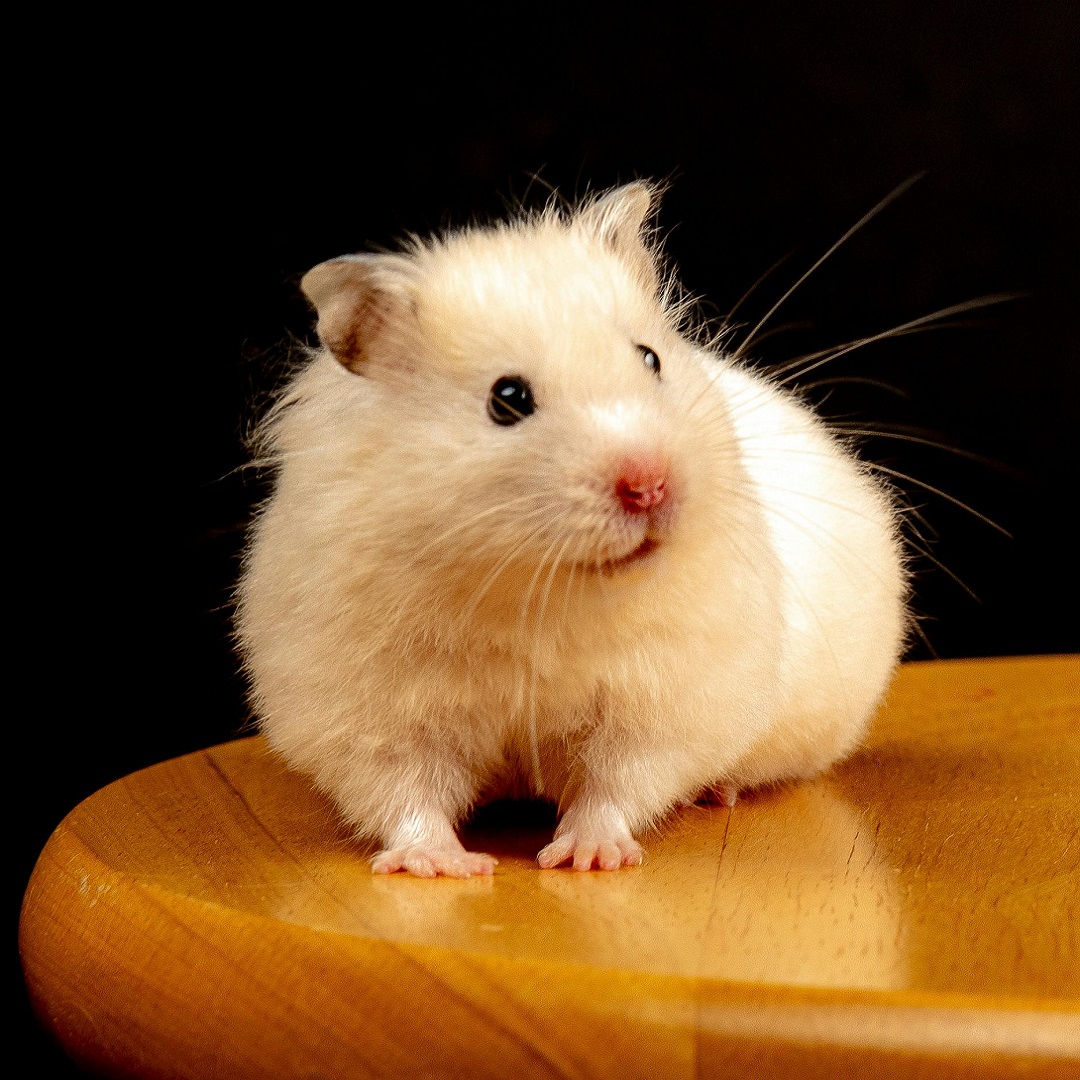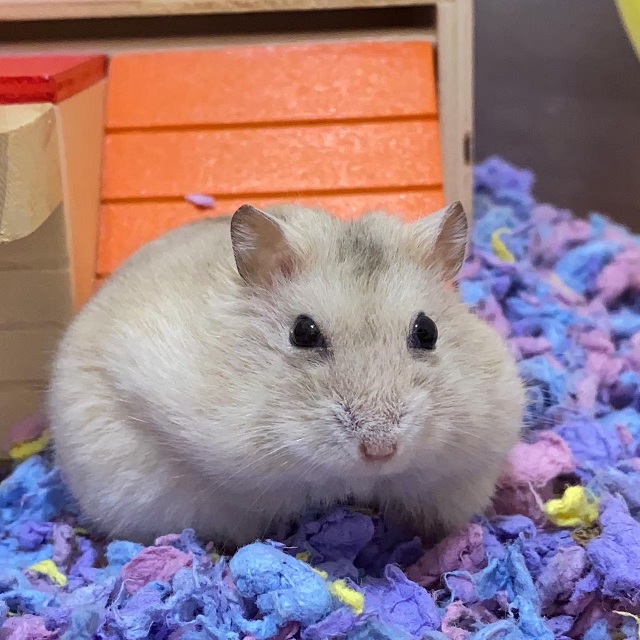Getting to Know Golden Hamsters (Syrian Hamsters)
The Syrian hamster, also known as the golden or teddy bear hamster, is relatively large among hamsters and can be quite destructive, possibly chewing through cages or wheels. However, they are generally friendly, not afraid of humans, and easy to care for.

Breed Traits, Characteristics, and Lifespan
- Body length: 12.5-17.5 cm (4.9-6.9 inches)
- Weight: 100-150 grams
- Lifespan: 2-3 years, sometimes up to 4 years
- Coat color: Originally golden, now includes white, gray, black, and spotted patterns.
- Habits: Nocturnal, active and curious, enjoys digging or building nests. Provide sufficient bedding like paper scraps or wood shavings. Highly territorial—must be kept alone after one month of age to prevent fighting.
Care Requirements
Optimal Temperature
72~82°F is the suitable temperature range. Anything colder or hotter is unsuitable. During summer, ceramic houses help keep cool, and there are metal cooling plates available. In winter, you can wrap a heat pack in a towel and place it under the cage to keep warm. Never place the cage outdoors due to noise—it may cause heatstroke or freezing. >>> Read More: 8 Ways to Maintain the Right Temperature in a Hamster Cage & How to Tell If It’s Too Hot or Cold
Cage Size and Type
Golden hamsters are larger in size, so the base of the cage should be at least 40×60 cm and well-ventilated. Avoid using traditional metal wire cages, as walking on metal bars can harm their feet. Hamsters may also chew on the bars, ingesting metal or getting stuck — a flat-bottomed cage is much safer. Golden hamsters are territorial, so only one hamster should be housed per cage. >>> Read More: Pros and Cons of 4 Types of Hamster Cages

Nowadays, many hamster cages are made from IKEA storage bins, which are spacious and easy to carry, clean, and customize. Image source:Shopee
Essential hamster furniture (top 4 required):
- Hamster wheel: Due to their large size, golden hamsters need a wheel with a diameter of 25cm (10 inches) to prevent spinal curvature. Avoid flying saucer wheels; use upright wheels instead.
- Water bottle: Make sure it doesn’t leak and change the water every 2–3 days to prevent bacteria growth.
- Food bowl
- Hamster hideout: A small shelter for your hamster to rest or store bedding/food. Options include ceramic, acrylic with water layers, cool glass, wood, and fabric. Consider whether it’s suitable for winter or summer and prioritize safety—check for gaps that may trap feet, wood splinters, or harmful chewable materials. Prepare a few to test what your hamster prefers.
- Chew sticks, , , and
- Sand bath for rolling and cleaning
- Temperature control items including metal cooling plate, heating pad, heat lamp
- Other tools like thermo-hygrometers, anti-chew posts, and tunnels.
>>> Read More: How to Choose the Right Hamster Cage Size – Must-Have Furnitures
Bedding Material
- Avoid compressed wood shavings like cedar or pine due to dust.
- Cotton or cloth can cause intestinal blockage or entangle limbs.
- Use dust-free, unscented bedding like paper-based options or shredded tissue. Change weekly to reduce odors.
>>> Read More: How Often Should You Change Hamster Bedding? Types, Pros & Cons, and Thickness?

Food and Restrictions
Safe Foods
In addition to commercial hamster pellets, you can offer the following foods. Make sure everything is unsalted, oil-free, and unseasoned. Be cautious with fruit due to its sugar content.
- Vegetables: Carrot, cucumber (high water content — feed in moderation), broccoli, water spinach, mustard greens, napa cabbage, cabbage, bell pepper, pumpkin, sweet potato, alfalfa sprouts, sweet potato leaves, corn, etc.
- Fruits: Choose low-sugar fruits, and always remove skin and seeds. Feed only a small piece per day. Avoid overfeeding high-sugar fruits such as:
Apple, papaya, guava, peach, cherry, kiwi, strawberry, blueberry, cranberry, wax apple, dragon fruit, watermelon/pear (high water content), banana, melon, etc. - Grains, Seeds, and Nuts: Nuts, sesame seeds, flaxseeds, cashews, peanuts (high in fat — limit to one per day), and cooked beans like black beans, soybeans, peas, etc.
- Protein Sources: Boiled eggs, cooked chicken, dried insects like mealworms or crickets (they’re crispy and smell like shrimp — hamsters love them!)
Foods to Avoid
Some foods that seem harmless to humans can be toxic or even deadly to hamsters. Please avoid the following:
- Spices and Alliums: Green onions, garlic, ginger, regular onions, leeks, chili peppers, etc.
- Tomato leaves
- Chocolate
- Caffeinated drinks: Coffee, tea
- Avocado
- Fruit seeds: Such as apple seeds, cherry pits (contain cyanide)
- Citrus fruits
- Cheese: Hamsters are lactose intolerant — if you really want to offer it, just a tiny, tiny amount
- Others: Mango, green (unripe) bananas, etc.
Read More: Full List of Safe and Unsafe Foods for Hamsters (Including Fruits, Vegetables, Grains, and More)
Common Health Issues
Here are some common health problems that Syrian hamsters may face:
Respiratory Infections
Often caused by bacteria or viruses. Symptoms include runny nose, sneezing, labored breathing, or wheezing.Digestive Problems
Diarrhea or constipation may occur due to improper diet, stress, or infections.Skin Diseases
Includes parasites (like mites and lice), fungal infections, or dermatitis — which can lead to hair loss, redness, or itching.Dental Issues
Hamster teeth grow continuously. Overgrown or misaligned teeth can cause eating problems and oral pain.Tumors
Common in older hamsters. These can be either benign or malignant.Eye Problems
Includes conjunctivitis or injuries. Symptoms include red eyes, swelling, or discharge.Wet Tail
A serious and potentially fatal condition, especially in young hamsters. Symptoms include diarrhea and a wet, dirty tail area. Immediate veterinary care is required.